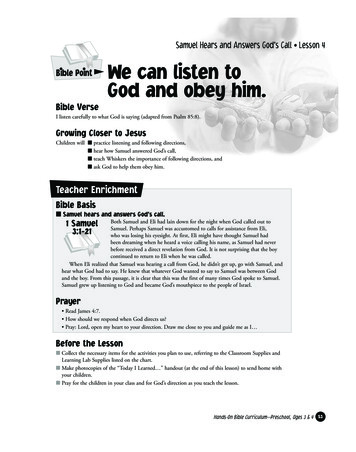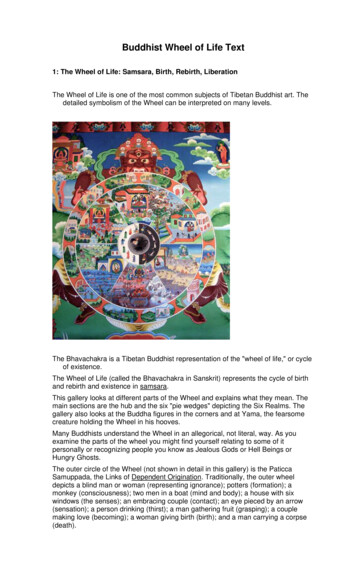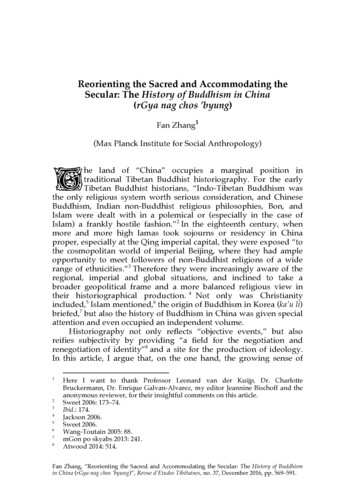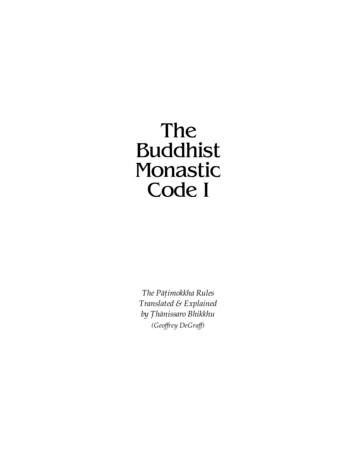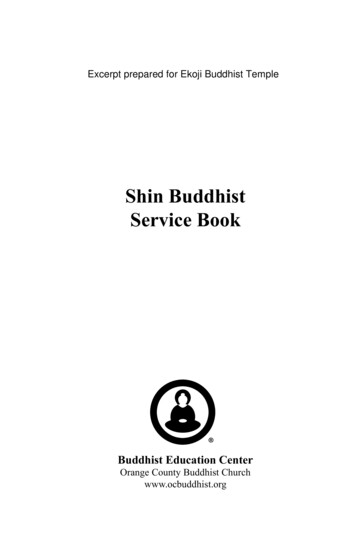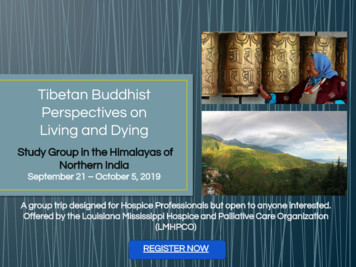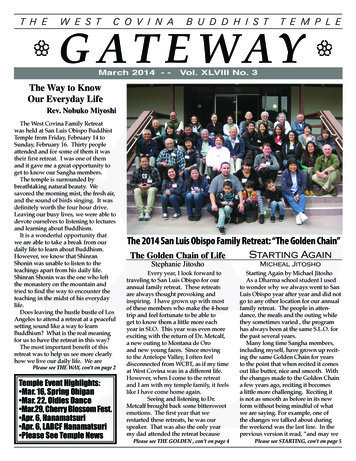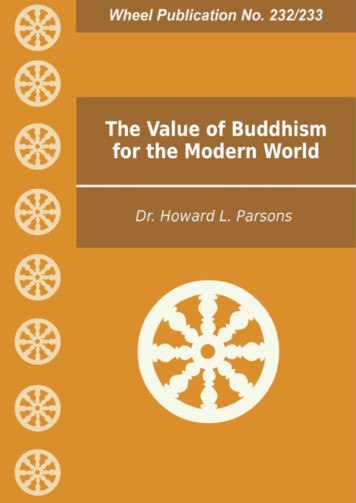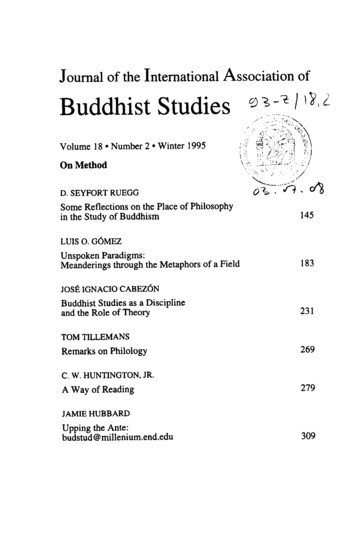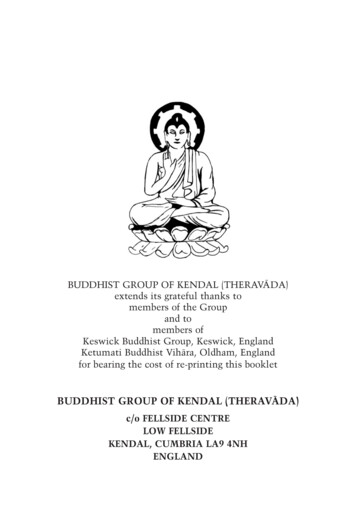
Transcription
BUDDHIST GROUP OF KENDAL (THERAVĀDA)extends its grateful thanks tomembers of the Groupand tomembers ofKeswick Buddhist Group, Keswick, EnglandKetumati Buddhist Vihāra, Oldham, Englandfor bearing the cost of re-printing this bookletBUDDHIST GROUP OF KENDAL (THERAVĀDA)c/o FELLSIDE CENTRELOW FELLSIDEKENDAL, CUMBRIA LA9 4NHENGLAND
BUDDHIST GROUP OF KENDAL(THERAVĀDA)INTRODUCINGBUDDHISMVenerable Dr Balangoda Ānanda MaitreyaMahānāyaka Thera Abhidhaja MaharatthaguruAggamahā Pandita DLitt D Litt (1896-1998)· ·andJayasili (Jacquetta Gomes BA DipLib MLS FRAS ALA)
INTRODUCING BUDDHISMContentsWhat is Buddhism? .2The Four Noble Truths .4The Eightfold Path .6The History and the Disposition of Traditions .8The Three Basic Facts of Existence .10Buddhist Meditation .12The Buddhist Teaching of Kamma and Rebirth .14Summing Up .16Buddhist Literature .18Glossary .20The Refuges and Precepts .24The Discourse on Loving Kindness .Inside Back Cover
The Discourse on Loving Kindness(Mettā Sutta, Sutta Pit.aka)1. One who is skilled in the good and who wishes to attain that state of calm,Nibbāna, should act thus: one should be sincere to oneself, upright andconscientious, of soft speech, gentle and not proud.2. Contented, living simply, peaceful and unburdened, with senses calmed,prudent, modest, and without showing anxiety for support.3. One should not commit any slight wrong on account of which wise men mightcensure one.May all beings be happy and secure, may their hearts be wholesome!4.-5. Whatever living beings there be – those mentally feeble or strong, physicallylong, stout or medium, short, small or large, those seen or unseen; dwelling faror near; those who are born and those who are to be born – may all beings,without exception, be happy-minded!6. Let none deceive another nor despise any person whatsoever in any place; inanger or ill-will let one not wish any harm to another.7. Just as a mother would protect her only child at the risk of her own life, in thesame way, let one cultivate a boundless heart towards all beings.8. Let thoughts of infinite love pervade the whole world – above, below andaround – without any obstruction, without any hatred, without any enmity.9. Whether standing, walking, sitting or lying down, as long as one is awake, thismindfulness should be developed: this, the wise say, is the highest conducthere.10. Not embracing false views, virtuous and endowed with insight, giving upattachment to sense desires – indeed, such a person does not come again forrepeated becoming (for rebirth).
CopyrightVenerable Dr Balangoda Ānanda MaitreyaMāhanāyaka Thera Abhidhaja MaharatthaguruAggamahā Pan. d. ita, DLitt DLitt (1896-1998)andJayasīlī (Jacquetta Gomes BA DipLib MLS FRAS ALA)1988, 1993 and 2003FOR FREE DISTRIBUTION ONLYNOT TO BE SOLD
What is Buddhism?Namo tassa Bhagavato Arahato Sammā Sambuddhassa!Homage to Him, the Exalted, the Worthy, the Fully Enlightened One!Buddhaṁ saran.aṁ gacchāmiDhammam saran.aṁ gacchāmiSanghaṁ saran.aṁ gacchāmiI go to the Buddha as my refugeI go to the Doctrine [Teaching] as my refugeI go to the Order [of monks and nuns] as myrefuge“The non-aggressive, moral and philosophical system expounded by the Buddha,which demands no blind faith from its adherents, expounds no dogmatic creeds,encourages no superstitious rites and ceremonies, but advocates a golden meanthat guides a disciple through pure living and pure thinking to the gain of supremevision and deliverance from all evil, is called the Dhamma and is popularly knownas Buddhism.” (Nārada, Buddhism in a Nutshell)THE TRIPLE GEM (TIRATANA)THE BUDDHAThe Buddha achieved enlightenment. He avoided the two extremes of selfindulgence (which retards spiritual progress) and self-mortification (whichweakens the intellect), and instead discovered and followed the Middle Path(Majjhimā Pat.ipadā) which led to his enlightenment. Thereafter he taught thispath until his death.The Buddha is not a God, nor a saviour who can save others. He explained thatdeliverance from suffering can only be gained by self-exertion and advised hisdisciples to be self-reliant.“Striving should be done by yourselves. The Tathāgatas [Buddhas] are onlyteachers.” (Dhammapada, verse 276)“Come O Kālāmas, do not accept anything on mere hearsay. Do not acceptanything by mere tradition. Do not accept anything on account of rumours. Do notaccept anything just because it accords with your scriptures. Do not acceptanything by mere supposition. Do not accept anything by mere inference. Do notaccept anything merely because it agrees with your preconceived notions. Do notaccept anything merely because it seems acceptable. Do not accept anythingthinking that the ascetic is respected by us. But when you know for yourselves –these things are immoral, these things are blameworthy, these things are censuredby the wise, these things, when performed and undertaken, conduce to ruin andsorrow – then indeed do you reject them. When you know for yourselves – thesethings are moral, these things are blameless, these things are praised by the wise,these things when performed and undertaken, conduce to well-being andhappiness – then do you live and act accordingly.” (Kālāma Sutta, Sutta Pit.aka)The Buddha said “He who sees the Dhamma sees me”. (Sutta Pit.aka)
THE DHAMMA“The Dhamma is good in the beginning, good in the middle and good in the end.”(Sutta Pit.aka)“The original Pāli term for Buddhism is Dhamma, which literally, means thatwhich upholds or sustains (him who acts in conformity with its principles andthus prevents him from falling into woeful states) The Dhamma is that whichreally is. It is the Doctrine of Reality. It is a means of deliverance from suffering,and deliverance itself. Whether the Buddhas arise or not the Dhamma exists fromall eternity. It is a Buddha that realizes this Dhamma, which lies hidden from theignorant eyes of men, till He, an Enlightened One, comes and compassionatelyreveals it to the world This sublime Dhamma is not something apart fromoneself. It is purely dependent upon oneself and is to be realized by oneself.”(Nārada, The Buddha and His Teachings)“Abide with oneself as an island with the Dhamma as a refuge.” (ParinibbānaSutta, Sutta Pit.aka)“The Dhamma He [The Buddha] taught is not merely to be preserved in books, noris it a subject to be studied from an historical or literary standpoint. On thecontrary, it is to be learned and put into practice in the course of one’s daily life,for without practice one cannot appreciate the truth. The Dhamma is to bestudied, and more to be practised, and above all to be realized [by one’s ownintuitive wisdom]; immediate realization is its ultimate goal. As such theDhamma is compared to a raft which is meant for the sole purpose of escapingfrom the ocean of birth and death (saṁsāra).” (Nārada, Buddhism in a Nutshell)“This sublime Dhamma deals with truth and facts that can be testified andverified by personal experience and is not concerned with theories andspeculations, which may be accepted as profound truths today and thrownoverboard tomorrow. The Buddha did not expound revolutionary philosophicaltheories, nor did He attempt to create a new material science. In plain terms Heexplained both what is within and without, so far as it concerns emancipationfrom the ills of life, and revealed the unique Path of Deliverance the Buddha didnot teach all that He knew He taught what He deemed was absolutely essentialfor one’s purification, and was characteristically silent on questions irrelevant toHis noble mission.” (Nārada, The Buddha and His Teachings)Although the Buddha did not leave any written teachings, his disciples (theSangha) recited and subsequently committed to writing the teachings.THE SANGHAThe Buddha established a Sangha (Order) of Bhikkhus (monks) and Bhikkhunīs(nuns).
The Four Noble Truths“One thing only does the Tathāgata [Buddha] teach, namely suffering and thecessation of suffering.” (Sutta Pit.aka)“In this very one-fathom long body, along with its perceptions and thoughts, do Iproclaim the world, the origin of the world, the cessation of the world, the pathleading to the cessation of the world.” (Rohitassa Sutta, Sutta Pit.aka)THE FOUR NOBLE TRUTHSARIYA SACCA1) The Noble Truth of Suffering2) The Noble Truth of the Origin of Suffering3) The Noble Truth of the Cessation of Suffering4) The Noble Truth of the Way to the Cessationof SufferingThis is the Noble Eightfold PathDukkha Ariya SaccaDukkha Samudaya Ariya SaccaDukkha Nirodha Ariya SaccaDukkha Nirodha GāminīPat.ipadā Ariya SaccaAriya At.t.hangika Magga“The truth of suffering is to be compared with a disease, the truth of the origin ofsuffering with the cause of the disease, the truth of the extinction of suffering withthe cure of the disease, the truth of the path with the medicine.” (Visuddhi Magga)“The Four Noble Truths are the briefest synthesis of the entire teachings ofBuddhism, since all those manifold doctrines of the threefold Canon (Tipit.aka) arewithout exception, included therein.” (Nyān.atiloka, Buddhist Dictionary)1) THE NOBLE TRUTH OF SUFFERINGDUKKHA ARIYA SACCA“Now this, O Bhikkhus, is the Noble Truth of Suffering. Birth is suffering, decayis suffering, disease is suffering, death is suffering, to be united with the unpleasantis suffering, to be separated from the pleasant is suffering, not to get what onedesires is suffering This Noble Truth of Suffering should be perceived.”(Dhammacakkappavattana Sutta, Sutta Pit.aka – The First Discourse of theBuddha).Dukkha can be translated as sorrowfulness, suffering or unsatisfactoriness. Thereare three types of dukkha:a) dukkha-dukkhaintrinsic or ordinary suffering (physical and mental)b) viparin.āma-dukkhasuffering due to changec) saṅkhārā-dukkhasuffering due to formations and as conditioned states(the general unsatisfactoriness of existence)The First Truth “shows that, in consequence of the universal law ofimpermanency, all the phenomena of existence whatsoever are subject tochange and dissolution, and hence are miserable and unsatisfactory; and that thus,without exception, they all contain in themselves the germ of suffering.”(Nyān.atiloka, Buddhist Dictionary)
2) THE NOBLE TRUTH OF THE ORIGIN OF SUFFERINGDUKKHA SAMUDAYA ARIYA SACCA“Now this, O Bhikkhus, is the Noble Truth of the Origin of Suffering. It is thiscraving [tan.hā] which produces rebirth, accompanied by passionate clinging,welcoming this and that (life). It is the craving for sensual pleasures, craving forexistence and craving for non-existence This Noble Truth of the Origin ofSuffering should be eradicated.” (Dhammacakkappavattana Sutta, Sutta Pit.aka)3) THE NOBLE TRUTH OF THE CESSATION OF SUFFERINGDUKKHA NIRODHA ARIYA SACCA“Now this, O Bhikkhus, is the Noble Truth of the Cessation of Suffering. It is thecomplete separation from, and destruction of, this very craving [tan.hā], itsforsaking, renunciation, the liberation therefrom, and non-attachment thereto This Noble Truth of the Cessation of Suffering should be realized.”(Dhammacakkappavattana Sutta, Sutta Pit.aka)The Third Noble Truth refers to Nibbāna (Enlightenment) which must be realizedfor oneself. It is necessary to eliminate the root of dukkha which is craving [tan.hā]for dukkha to be eliminated and Nibbāna to be attained.4) THE NOBLE TRUTH OF THE WAY TO THE CESSATION OF SUFFERINGDUKKHA NIRODHA GĀMINĪ PAT. IPADĀ ARIYA SACCA“Now this, O Bhikkhus, is the Noble Truth of the Path leading to the Cessation ofSuffering. It is the Noble Eightfold Path This Noble Truth of the Path leading tothe Cessation of Suffering should be developed.” (DhammacakkappavattanaSutta, Sutta Pit.aka)The Noble Eightfold Path must be followed to realize Nibbāna.THE NOBLE EIGHTFOLD PATHARIYA AT. T. HANGIKA MAGGAWISDOM1) Right View or Understanding2) Right Thoughts or IntentionsPAÑÑĀSammā Dit.t.hiSammā SaṁkappaMORALITY3) Right Speech4) Right Action5) Right LivelihoodSĪLASammā VācāSammā KammantaSammā ĀjivaCONCENTRATION6) Right Effort7) Right Mindfulness8) Right ConcentrationSAMĀDHISammā VāyāmaSammā SatiSammā Samādhi
The Eightfold Path“What, O Bhikkhus [monks] is that Middle Path the Tathāgata [Buddha] hascomprehended which promotes sight and knowledge, and which tends to peace,higher wisdom, enlightenment and Nibbāna? The very Noble Eightfold Path.”(Dhammacakkappavattana Sutta, Sutta Pit.aka)The “Noble Eightfold Path avoids the extreme of self-mortification thatweakens one’s intellect and the extreme of self-indulgence that retards one’s moralprogress”. (Narada, The Buddha and His Teachings) Consequently the Buddhacalls this path the middle way (majjhimā pat.ipadā).THE FOUR NOBLE TRUTHS1)2)3)4)ARIYA SACCAThe Noble Truth of SufferingDukkha Ariya SaccaThe Noble Truth of the Origin of SufferingDukkha Samudaya Ariya SaccaThe Noble Truth of the Cessation of Suffering Dukkha Nirodha Ariya SaccaThe Noble Truth of the Way to the Cessation Dukkha Nirodha Gāminiof SufferingPat.ipadā Ariya SaccaThis is the Noble Eightfold PathAriya At.t.hangika MaggaTHE NOBLE EIGHTFOLD PATHARIYA AT. T. HANGIKA MAGGAWISDOM1) Right View or Understanding2) Right Thoughts or IntentionsPAÑÑĀSammā Dit.t.hiSammā SaṁkappaMORALITY3) Right Speech4) Right Action5) Right LivelihoodSĪLASammā VācāSammā KammantaSammā ĀjīvaCONCENTRATION6) Right Effort7) Right Mindfulness8) Right ConcentrationSAMĀDHISammā VāyāmaSammā SatiSammā SamādhiMORALITY (SĪLA), CONCENTRATION (SAMĀDHI ) ANDWISDOM (PAÑÑĀ)When considered from the standpoint of practical training the Noble EightfoldPath consists of the following three groups:1) Moral Discipline Group2) Concentration Group3) Wisdom dha
WISDOM (PAÑÑĀ)1)a)b)c)RIGHT VIEW OR UNDERSTANDING (SAMMĀ DIT.T. HI)Right View of kammaRight View of the ten kinds of subjectsRight View of the Four Noble Truths2)a)b)c)RIGHT THOUGHTS OR INTENTIONS (SAMMĀ SAṀKAPPA)Thoughts of renunciation (opposed to greed and sensual desire)Thoughts of benevolence for the welfare of all beings (opposed to ill-will)Thoughts of harmlessness for all beings (opposed to cruelty)MORALITY (SĪLA)3)a)b)c)d)RIGHT SPEECH (SAMMĀ VĀCĀ)Refraining from false speechRefraining from slanderous speechRefraining from harsh words and abusive languageRefraining from idle chatter and frivolous talk4)a)b)c)RIGHT ACTION (SAMMĀ KAMMANTA)Refraining from killing and injuring any living beingRefraining from taking anything not freely givenRefraining from sexual misconduct and abuse of the senses5) RIGHT LIVELIHOOD (SAMMĀ ĀJĪVA)The following types of livelihood should be avoided:a) Dealing in weapons and armsb) Dealing in human beings (e.g. prostitution and slavery)c) Dealing in living beings and flesh (e.g. butchery)d) Dealing in intoxicating drinkse) Dealing in poisonWrong livelihood by means of immoral physical and verbal actions (e.g. deceit,soothsaying, treachery, trickery, usury) should be avoided.CONCENTRATION (SAMĀDHI)6)a)b)c)d)RIGHT EFFORT (SAMMĀ VĀYĀMA)The effort to prevent the arising of unarisen unwholesome statesThe effort to discard unwholesome states already arisenThe effort to develop unarisen wholesome statesThe effort to promote wholesome states already arisen7) RIGHT MINDFULNESS (SAMMĀ SATI)The Four Foundations of Mindfulness:a) Mindfulness of the bodyb) Mindfulness of feelingsc) Mindfulness of consciousness or states of mindd) Mindfulness of mental objects or phenomena (dhammas)8) RIGHT CONCENTRATION (SAMMĀ SAMĀDHI)This is one-pointedness of the mind developed through meditation. (The jhānas)
History and the Disposition of Traditions“A unique being, an extraordinary man arises in this world for the benefit of themany, for the happiness of the many, out of compassion for the world Who is thisunique being? It is the Tathāgata [the Buddha], the Exalted, Fully Enlightened One.”(Sutta Pit.aka)THE LIFE OF THE BUDDHAA Prince was born on the full moon day of May 623 BC (according to some schoolsof Buddhism) in Lumbini Park at Kapilavatthu, on the present day borders of Indiaand Nepal. His father was King Suddhodana of the Sākya clan. The Prince wasnamed Siddhattha (which means wish fulfilled). His family name was Gotama.Eight distinguished Brahmins examined the prince. It was declared that he wouldeither become a universal monarch or would retire from the world and become aBuddha.During his childhood the Prince was left unattended under a rose apple tree at aploughing festival. He meditated on the breath and achieved one-pointedness ofmind. At the age of sixteen he married his cousin Princess Yasodharā. He lived ahappy married life for thirteen years in luxurious conditions created by his father,to shelter him from the realities of life. While being driven in his carriage outsidethe palace he saw four signs which changed his view of the world: an old man, asick person, a corpse, and an ascetic. At the age of twenty-nine he decided torenounce the world to search for the Truth.Siddhattha left the palace and became a homeless ascetic. He studied under twoteachers, Ālāra Kālāma and Uddaka Rāmaputta, mastered their teachings and leftthem to search for the Truth. Five ascetics joined him. For about six years hepractised extreme austerities. Remembering the one-pointedness of mind achievedunder the rose apple tree and seeing the futility of excessive austerity he decidedto renounce these extreme ascetic practices. His five companions deserted him,fearing that he had returned to a life of luxury.On the Full Moon day of May in his 35th year he sat under the Bodhi tree atBuddhagayā and attained Buddhahood (achieved enlightenment). Thereafter he isknown as the Buddha (the Enlightened or the Awakened One). The Buddha referredto himself as the Tathāgata (He who has thus gone).The Buddha walked to the Deer Park at Isipatana near Baranasi (formerly Benares)to join his five erstwhile companions. On the Full Moon Day of July 528 BC(according to some schools of Buddhism) the Buddha delivered his First Discourse.The Buddha subsequently established a Sangha (order) of both Bhikkhus (monks)and Bhikkhunīs (nuns).The Buddha’s ministry lasted for forty-five years. He died at the age of eighty onthe Full Moon day of May 543 BC (according to some schools of Buddhism) in theSāla Grove at Kusinārā. This is known as the Parinibbāna of the Buddha.
THE COUNCILSCouncils of Enlightened Bhikkhus (Arahats) were held three months, 100 yearsand 236 years after the passing away of the Buddha. At the First Council theTipit.aka (Teachings) were recited. A further Council of Arahats was held in thefirst century BC in Sri Lanka, and the Tipit. aka was committed to writing. One ofthe authors of this booklet, Venerable Balangoda Ānanda Maitreya, activelyparticipated in the sixth and most recent Buddhist Council held in Burma (nowMyanmar) from 1954-56 to mark the 2500th anniversary of the passing away of theBuddha.SCHOOLS OF EARLY BUDDHISMAfter the passing away of the Buddha eighteen schools of early Buddhismdeveloped. Of these only Theravāda (The Teaching of the Elders) survives today.THE GREATER VEHICLE (MAHĀYĀNA)In the first century AD, Mahāyāna Buddhism developed as a separate tradition. Itwas known to its adherents as the Greater Vehicle, in contrast to the contemporarymonastic based Buddhism, which the Mahāyānists named the Hīnayāna (LesserVehicle).Mahāyāna Buddhism adopted Sanskrit as its language. The Bodhisattva (Pāli:Bodhisatta) ideal emerged of a person who refuses to enter Nirvān.a (Pāli:Nibbāna), but instead returns to saṁsāra to help others. Compassion and wisdombecame the most important virtues. The role of lay people was developed.THE DIAMOND VEHICLE OR TANTRA (VAJRAYĀNA)Tantra emerged between the 3rd and 7th centuries AD. Tantra involves a rapidattainment of Buddhahood through specialised forms of meditation which makewide use of visualisation and images.THE SPREAD OF BUDDHISM FROM INDIA1) The Southern TransmissionBuddhism spread into Burma (now Myanmar), Indonesia, Kampuchea, Laos, SriLanka and Thailand. Consequently Theravāda Buddhism is often known as theSouthern School.2) The Northern TransmissionMahāyāna Buddhism spread initially along the North-Western frontier and theSilk Road. It reached Bhutan, China, Indonesia, Japan, Korea, Mongolia, Nepal,Tibet, former USSR and Vietnam.3) Buddhism in the WestIn the 19th century European scholars started to study Buddhism. Buddhism hasspread greatly since 1945, partly because of the work of expatriate communitiesand partly because of indigenous interest.
The Three Basic Facts of Existence“Whether the Tathāgatas [Buddhas] appear or not, O Bhikkhus (monks), it remains afact, an established principle, a natural law that all conditioned things are transient(anicca), sorrowful (dukkha) and that everything is without a self (anattā).” (SuttaPit.aka)The Three Basic Facts of Existence are also known as the Three Characteristics,the Three Signata or the Three Signs. The formula for the Three Basic Facts givenin verses 277-9 of the Dhammapada is:Sabbe saṅkhārā anicca all conditioned things are impermanent, transientSabbe saṅkhārā dukkha all conditioned things are sorrowful, unsatisfactorySabbe dhammā anattā all phenomena are without ego, self, substanceTHE THREE BASIC FACTS OR CHARACTERISTICS (TI-LAKKHAN. A)1) anicca2) dukkha3) anattāimpermanence, transience, transitorinesssorrowfulness, suffering, unsatisfactorinessegolessness, impersonality, non-ego, non-self, unsubstantiality1) ANICCA (IMPERMANENCE, TRANSIENCE, TRANSITORINESS)“Impermanency is the rising, passing away and changing of things, or thedisappearance of things that have become or arisen. The meaning is that thesethings never persist in the same way, but that they are dissolving and vanishingfrom moment to moment.” (Visuddhi Magga)2) DUKKHA (SORROWFULNESS, SUFFERING, UNSATISFACTORINESS)Dukkha is the unsatisfactory nature of all conditioned phenomena. These are allliable to suffering because of their impermanence.“Birth is suffering, decay is suffering, disease is suffering, death is suffering, to beunited with the unpleasant is suffering, to be separated from the pleasant issuffering, not to get what one desires is suffering. In brief, the five aggregates ofattachment are suffering.” (Dhammacakkappavattana Sutta, Sutta Pit.aka) (TheFirst Discourse of the Buddha.)3) ANATTĀ (EGOLESSNESS, IMPERSONALITY, NON-EGO, NON-SELFUNSUBSTANTIALITY)There is no self-existing, real ego-identity, nor a soul, nor any other abidingsubstance.The Buddha is known as Anattā-vādi (the teacher of impersonality) since this is ateaching unique to Buddhism.
FIVE AGGREGATES, GROUPS OF CLINGING OR EXISTENCE(PAÑC’UPĀDĀNA-KKHANDHA)According to Buddhist teaching the so-called being consists of five khandas oraggregates:1)2)3)4)5)rūpa-kkhandhaaggregate of matter (compared to a lump of froth)vedanā-kkhandha aggregate of feelings (compared to a bubble)saññā-kkhandhaaggregate of perceptions, memories (compared to a mirage)saṅkhāra-kkhandha aggregate of mental formations, states (banana tree trunk)viññān. a-kkhandha aggregate of consciousness (a conjuring trick)All physical and mental phenomena are included in these five aggregates.ANATTALAKKHANA SUTTA (SUTTA PIT. AKA)This is the Second Discourse of the Buddha. The Buddha asks his first fivedisciples:“What do you think, O monks: Is this body permanent or impermanent?Impermanent Lord. Are feelings, perceptions, mental formations andconsciousness, permanent or impermanent? Impermanent Lord.But that which is impermanent, is it something pleasant or painful? It is painful,Lord.But, of what is impermanent, painful and transitory, could it rightly be said ‘Thisbelongs to me, this I am, this is Ego’? No Lord.Therefore whatever there is of corporeality, feeling, perception, mental formationsand consciousness, whether past, present or future, one’s own or external, gross orsubtle, low or high, far or near, of all these things one should understand, accordingto reality and true wisdom ‘This does not belong to me, this I am not, this is notmy ego’.”UNDERSTANDING AND MEDITATING ON THE THREE BASIC FACTS“Existence can be understood only if these Three Basic Facts are comprehended,and this is not only logically, but in confrontation with one’s own experience.Insight-wisdom (vipassanā-paññā) which is the ultimate liberating factor inBuddhism, consists just of this experience of the Three Characteristics applied toone’s own bodily and mental processes and deepened and matured in meditation To ‘see things as they really are’ means seeing them consistently in the light ofthe Three Characteristics.” (Nyān.aponika, The Basic Facts of Existence: I,Impermanence Collected Essays, Wheel No 186-7)Vipassanā (insight) “is the intuitive light flashing forth and exposing the truth ofthe impermanency, the suffering and the impersonal and unsubstantial nature ofall corporeal and mental phenomena of existence.” (Nyān.atiloka, BuddhistDictionary)
Buddhist MeditationThe Pāli word bhāvanā means mental culture or mental development. “Buddhistbhāvanā is mental culture in the full sense of the term. It aims at cleansing themind of impurities and disturbances, such as lustful desires, hatred, ill-will,indolence, worries and restlessness, sceptical doubts, and cultivating suchqualities as concentration, awareness, intelligence, will, energy, the analyticalfaculty, confidence, joy, tranquillity, leading finally to the attainment of highestwisdom which sees the nature of things as they are, and realizes the UltimateTruth, Nibbāna.” (Walpola Rāhula, What the Buddha Taught)In Buddhism there are two kinds of meditation:1) Samatha-bhāvanāSamatha is the development of one-pointedness of mind and concentration.Samādhi is the concentrated, peaceful, still and unshaken state of mind.2) Vipassanā-bhāvanāVipassanā is the intuitive insight into the nature of things and leads to therealization of Nibbāna (enlightenment).MEDITATION SHOULD ALWAYS BE STUDIED UNDER A QUALIFIED TEACHER!DIVINE ABODES/SUBLIME STATES (BRAHMAVIHĀRAS)BOUNDLESS STATES/ILLIMITABLES hāloving kindness (direct enemy hatred, indirect enemy affection)compassion (direct enemy cruelty, indirect enemy passionate grief)sympathetic joy (direct enemy jealousy, indirect enemy exhilaration)equanimity (direct enemy attachment and aversion, indirect enemycallousness)Mettā bhāvanā is frequently practised as a form of samatha meditation.“Mettā should be practised first towards oneself. In doing so a person shouldcharge his mind and body with positive thoughts of peace and happiness. Heshould think how he could be peaceful, happy, free from suffering, worry andanger. He then becomes the embodiment of loving kindness. Shielded by lovingkindness, he cuts off all hostile vibrations and negative thoughts. He returns goodfor evil, love for anger. He becomes ever tolerant and tries his best not to giveoccasion for anger to any. Himself beaming with happiness, he injects happinessinto others not only inwardly but also outwardly by putting his mettā into practicein the course of his daily life.When he is full of peace and is free from thoughts of hatred, it is easy for him toradiate loving kindness towards others. What he does not possess he cannot giveto others. Before he tries to make others happy he should first be happy himself.He should know the ways and means to make himself happy.” (Nārada, TheBuddha and His Teachings)
MEDITATION ON BREATHING (ĀNĀPĀNA SATI)Meditation on the breath can be used to develop samādhi and vipassanā.DEVELOPMENT OF CONCENTRATION (SAMATHA)“He may watch his inhalation and exhalation at the start. By no means should heforce breath in or out. He should just be aware of his breath as it passes in and outwhile letting the breath go in and out automatically in its own way. He has onlyto be watchful, mindful, and attentive to it. If he is a long-nosed person, the breathwill touch the tip of his nose first, and if his nose is a short one, the breath willtouch his upper lip first. He should fix his mind and attention on the spot thebreath first touches, the tip of the nose or the upper lip, as the case may be Tobe conscious and mindful of, or attentive to, one’s breath is the preliminary step ofthis practice ” (Balangoda Ānanda Maitreya, Meditation on Breathing)INSIGHT-DEVELOPMENT (VIPASSANĀ)“Some meditators practise vipassanā (insight-development) from the beginning.They do not try to attain ecstatic trances. They start with being mindful ofinhalation and exhalation. Then by counting breaths they developconcentration and mindfulness. Next, they stop counting and develop mindfulnessover extension of breaths both long and short, and then contemplate over the start,middle and end of inhalations and exhalations. They examine the feelings thatarise at the breath’s first touch on the tip of the nose or upper lip and seeimpermanence, unsatisfactoriness and egolessness of feelings. Then they examinethe consciousness (mind-unit), perception (saññā) and
Buddhism, since all those manifold doctrines of the threefold Canon (Tipit.aka) are without exception, included therein." (Nya n.atiloka, Buddhist Dictionary) 1) THE NOBLE TRUTH OF SUFFERING DUKKHA ARIYA SACCA "Now this, O Bhikkhus, is the Noble Truth of Suffering. Birth is suffering, decay
